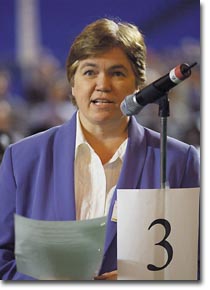BY JENNIFER MAE BARIZO and Adventist Review Staff
On July 2, 2000, newly reelected president Jan Paulsen launched the first ever "Windows on Mission," an unprecedented series of assemblies designed to foster dialogue between delegates and leaders concerning key issues in the church.
Paulsen identified five windows that will be discussed during the daily sessions: strategic thinking, witnessing to other religions, clergy/lay unity, discipleship training, and financial resourcing.
"We want to open these various windows in a creative way," declared Paulsen. "We want you to talk back to leadership. We crave your comments. This exercise is a failure if you don't talk to us. View these windows carefully, even critically, for criticism in a church context is constructive. Share the convictions you have on your heart.
"Let's see how the Spirit guides us through this exercise."
Dr. George Knight, professor of church history at Andrews University, challenged the delegates to think about the future of the church from the devil's viewpoint. Knight outlined a 15-point agenda the devil might devise in his fight against the Seventh-day Adventist Church.

Newbold College president Andrea Luxton was one of many delegates that shared there vision for the church. |
"If I were the devil, I would get people to believe that there is only one way to do something and that everyone had to do it that way," said Knight to repeated delegate applause.
"If I were the devil, I would put my best energies into getting the church to reject the ideas of the coming generation," Knight continued, highlighting the youth of the church as "its greatest asset" and "Adventism's greatest opportunity."
Knight cited church cofounder Ellen G. White in support of creative approaches to ministry: "New methods and new plans will spring from new circumstances. New thoughts will come with new workers who give themselves to the work. . . . They will receive plans devised by the Lord Himself" (Testimonies, vol. 6, p. 40).
Other key areas of emphasis should include the importance of technology to the future church and the priority of the local congregation, according to Knight.
Vice president Phil Follett and Kermit Netteburg, NAD vice president for communication, invited delegates to divide into small groups to identify strategic opportunities, threats, and challenges that the church faces.
Delegates across the floor huddled in groups of six and seven comparing notes and ideas.
A 15-minute open forum concluded the first afternoon's session. Delegates lined up 20 deep at the microphone to report their group's conclusions.
"I believe that the church's secularism has become its greatest threat," said Simion Obong'o Nyachieng'a, from the Eastern African Division.
Delegate Tunde Ojewole (Africa-Indian Ocean Division) echoed a similar concern: "The greatest challenge of the church is the tendency of going away from biblical fidelity. We must have as our underlying concern, staying true to 'Thus says the Lord.'"
Andrej Godina (Trans-European Division) saw an opportunity for the church in world crises: "All the suffering going on in the world gives us the opportunity to shine and share Jesus' love."
Luciano Nermal, Jr., Southern Asia-Pacific Division, identified the church's ongoing need for revival and reformation as its greatest challenge. According to Nermal, materialism destroys the unity of the movement.
Eastern African Division delegate George Mwansa summarized the church's greatest challenges in three words: "Racism, tribalism, regionalism."
Achieving balance between young and old, tradition and principle, and between mass media and personal contact are three of the church's greatest challenges, according to Ronald Bissell, a theology teacher in the Philippines.
Half a dozen delegates highlighted the urgency of the church's ministry to its own youth through education and pastoral care, as well as the necessity of equipping them for service. "We need to allow young people to reshape and restate church," said Larry J. Pitcher, from the General Conference executive committee.
U.S. Navy Rear Admiral Barry Black called for inclusiveness, especially in regard to roles for women. "We must demonstrate to the world the strength of our diversity."


 FREE NEWSLETTER
FREE NEWSLETTER